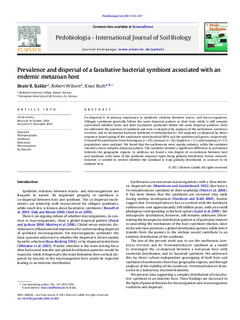Prevalence and dispersal of a facultative bacterial symbiont associated with an endemic metazoan host
Journal article, Peer reviewed
Permanent lenke
http://hdl.handle.net/11250/134392Utgivelsesdato
2011Metadata
Vis full innførselSamlinger
Sammendrag
Co-dispersal is of primary importance in symbiotic relations between macro- and micro-organisms.
Obligate symbionts generally follow the same dispersal pattern as their host, while it still remains
unresolved whether hosts and their facultative symbionts follow the same dispersal patterns. Here
we addressed the question of symbiont and host co-dispersal by analyses of the earthworm Lumbricus
terrestris, and its facultative bacterial symbiont Verminephrobacter. We analyzed co-dispersal by direct
sequence-based typing of the earthworm mitochondrial ND4, and the symbiont adk genes, respectively.
A total of 96 earthworms from Norwegian (n = 20), German (n = 20), English (n = 31) and Canadian (n = 25)
populations were analyzed. We found that the earthworms were mainly endemic, while the symbiont
showed a more complex dispersal pattern. The symbiont showed a significant difference in prevalence
between the geographic regions. In addition, we found a low degree of co-evolution between host
and symbiont, with some of the symbiont sequence types being globally distributed. Future research,
however, is needed to resolve whether the symbiont is truly globally distributed, in contrast to its
endemic host.
